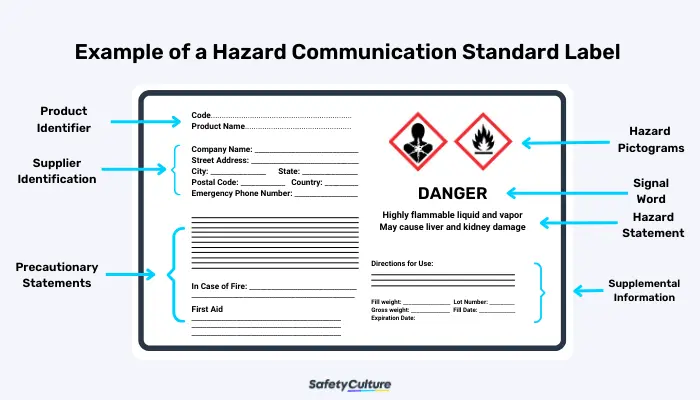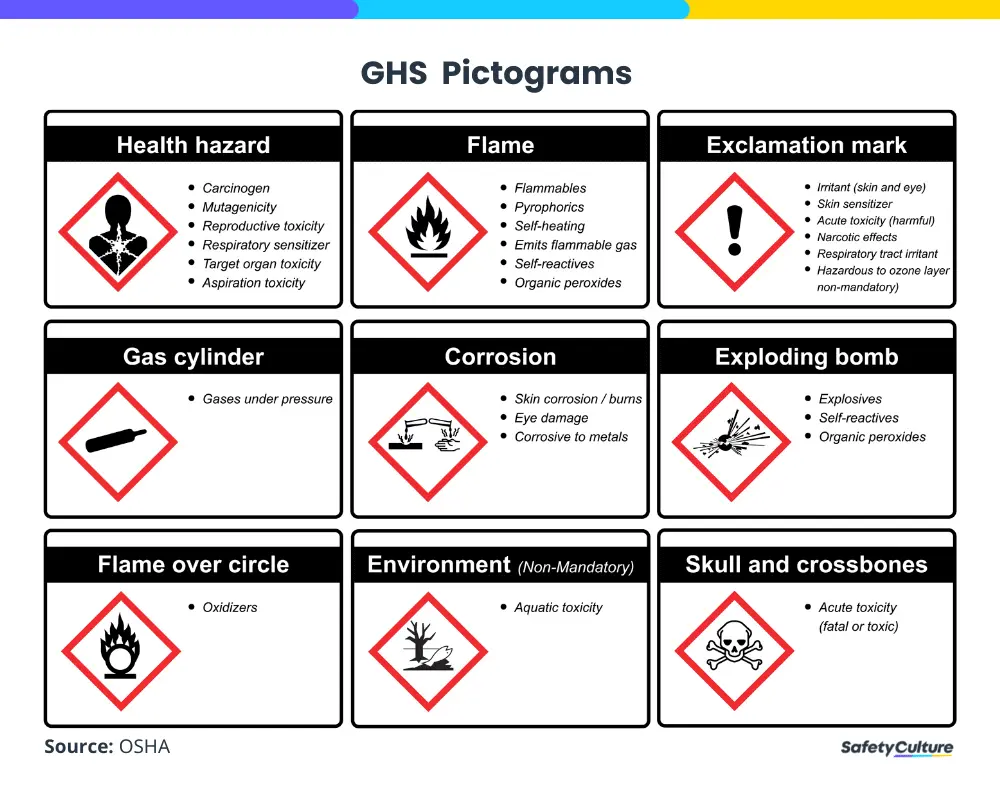What is Hazard Communication (HazCom)?
Hazard Communication Standards, also known as HazCom or the “Right-to-Know Law,” is a set of standards or rules created by OSHA that intend to keep employees informed about chemical hazards or potential hazards in the workplace through proper labeling of containers, the use of Safety Data Sheets (SDS), and employee training. Workers or employees may be exposed to different chemical hazards and they have the right to know what they are getting exposed to while working. This is the reason HazCom was established. When workers are informed, they, and the people responsible for their safety, can take steps to help ensure that they are going to be protected from risks and hazards.
Routes of Chemical Exposure
Certain chemicals can cause harm when people get exposed to them. Such chemicals can come in contact in several ways:
- Inhalation – breathing in toxic vapors or small chemical particles
- Absorption – this can happen due to direct exposure to the skin or by touching a chemical substance
- Injection – that is when a sharp contaminated object accidentally penetrates a worker’s body
- Ingestion – that is when toxins are accidentally swallowed or accidentally mixed with foods
Update to the Hazard Communication Standard (HCS)
The HazCom rule specified in the 29 CFR 1910.1200 HAZCOM standard was updated in March 2012 to be aligned with the U.N. Globally Harmonized System of Classification and Labeling of Chemicals (GHS).
What is GHS?
The GHS was developed by the United Nations in the 1990s to standardize the classification and labeling of chemical substances. People who work with hazardous materials need to know what to do in event of an accident. This is the primary goal of GHS—to standardize hazard criteria, use pictograms, and simplify safety data sheets that give workers essential information for their protection.
With the old HCS, workers have found the information provided in the safety data sheets difficult to understand. Many terminologies and chemical information are incomprehensible. This is the reason the “Right-to-Know” Law was updated to become the workers’ “Right-to-Comprehend” or understand.
Because of this change to HCS, a more simplified and comprehensive approach to identifying chemicals and presenting hazard information on labels and safety data sheets became available. All businesses that have hazardous chemicals in their workplaces are required to provide labels and safety data sheets to their exposed workers, as well as to train them on how to properly handle the chemicals.
Improve your EHS Management
Cultivate a safe working environment and streamline compliance with our EHS solutions.
Explore nowMajor Changes to HCS
Manufacturers, importers, and distributors must be aware of and comply with changes in the standard labeling of chemicals. The following are the changes in the updated HCS, from the 1990s version to 2012:
- Hazard classification – It is now required that chemical manufacturers provide specific criteria for the classification of health, physical, and environmental hazards, as well as the classification of mixtures.
- Labels – Chemical manufacturers and importers are now required to provide a label that complies with the standards such as putting a signal word, pictograms, hazard statements, and precautions.
- Safety Data Sheets – It is now required for employers to provide SDS that’s in a 16-section format.
- Employee training – Employers are required to train new workers and inform workers about new chemicals they’ll encounter in the workplace.
Hazard Classification
Classifying hazards in the workplace is the right place to begin with in hazard communication. Employers have to be transparent with the information regarding chemical hazards in their workplaces. GHS has divided the different types of hazards into three major classifications. These classifications must be present in the labels as required by HazCom:
- Physical hazards – classes include: explosives, flammable materials and gases, gases under pressure, flammable liquids, flammable solids, and self-reactive substances and mixtures, among others.
- Health hazards – classes include: skin irritation, eye irritation, germ cell mutagenicity, carcinogenicity, reproductive toxicity, and many more.
- Environmental hazards – classes include hazards to bodies of water and the ozone layer.
Hazard Communication Standard Labels
Standard labels are used to show how dangerous the hazard is and to inform the reader to be cautious. Presently, there are two approved GHS signal words that can be used. Only one signal word should be used on each label:
OSHA’s HazCom now requires the following elements on labels of hazardous chemicals:
- Contact details that include the name, address, and phone number of the manufacturer, importer, or other point person.
- Product Identifier – this includes the chemical name, code number, or batch number provided by the manufacturer, importer, or distributor.
- Signal Words – this is intended to alert the reader on the severity of the hazard. There are two approved GHS signal words—“Danger” and “Warning”—but only one signal word should be used per label:
- “Danger” is used if the chemical poses an immediate threat, like death or long-term health problems.
- “Warning” is used if a substance poses health problems when exposed.
- Hazard Statements – includes a description of the hazards and the degree of danger.
- Precautionary Statement – describes what are the steps to be taken or what measures should be taken in case of exposure, improper storage, or improper handling.
- Pictograms – these are the symbols that convey specific information about the hazards of a substance.
- Supplementary Information – these are additional instructions or information that may be helpful for the reader of the label.
GHS Hazard Pictograms
Since aligning with the GHS, it is now required by HCS to use pictograms on chemical labels. GHS has nine hazard pictograms and they are as follows:
- Health Hazard Pictogram–used for carcinogens, chemicals that cause mutations, or cause damage to organs when inhaled
- Flame Pictogram–used for gases, aerosols, liquids, and solids that are flammable.
- Exclamation Mark Pictogram–used for chemicals that can enter the body through skin absorption or respiration
- Gas Cylinder Pictogram–used to indicate compressed gases, gases that have been dissolved, or liquified gases.
- Corrosion Pictogram–used to depict that the chemical damage or destroy metals, cause irreversible damage to the skin, and may cause damage to the vision.
- Exploding Bomb Pictogram–used for chemicals that may cause explosions and those that are self-reactive.
- Flame Over Circle Pictogram–used for chemicals that can oxidize and lose electrons.
- Skull & Crossbones Pictogram–used for fatal or toxic chemicals
GHS Hazard Statements List
The hazard statements list is grouped by the classification of hazards mentioned earlier. Each statement has its corresponding codes based on the chemical’s properties. See the complete list here: hazard statements list.
GHS Precautionary Statements List
A precautionary statement is a phrase that may be used to give information and guidance on how to avoid having adverse effects from being exposed to a hazardous substance or mixture.
Examples include:
- wear eye protection
- do not eat, drink or smoke when using this product
- avoid release to the environment
View the complete list here: Precautionary statements list.
Safety Data Sheets
Safety data sheets are called Material Safety Data Sheets (MSDS) before the HCS was updated. It now has a specified 16-section format. SDS must provide comprehensive information about substances and mixtures used in workplaces. They are a source of information about hazards and safety precautions. The 16-section format of safety data sheets appears in this order:
- Identification
- Hazard(s) identification
- Composition/information on ingredients
- First-aid measures
- Fire-fighting measures
- Accidental release measures
- Handling and storage
- Exposure controls/personal protection
- Physical and chemical properties
- Stability and reactivity
- Toxicological information
- Ecological information
- Disposal considerations
- Transport information
- Regulatory information
- Other information
Create Your Own Safety Data Sheet Template
Eliminate manual tasks and streamline your operations.
Get started for FREEHazCom Training
Employers are required to train their workers to understand and comply with HazCom. They should be trained on the following:
- Label information
- Safety Data Sheets (SDS)
- Pictograms
Complying with these HazCom policies and precautions while implementing a comprehensive integrated management system can help to ensure that all hazards in the workplace are properly categorized and that the appropriate information is relayed to employees.





